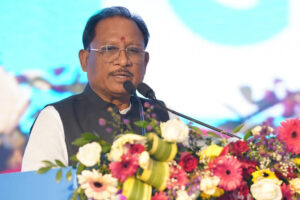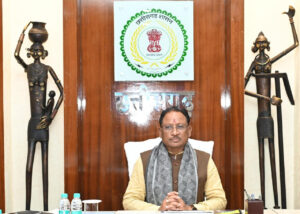Raipur June 15, 2025: The initial results of the rationalisation of teachers drive in Chhattisgarh are highly promising as after the comprehensive drive, the number of teacherless schools in the state has gone absolutely zero.
Most importantly, the state Education Department said that no school is being closed and no teacher post is being eliminated. Instead, the focus is on ensuring that schools run with better infrastructure.
After rationalisation, the number of teacherless schools in the state has gone to zero.
The number of single teacher schools has decreased by an impressive 80 per cent. Now, about 1,200 schools are single teacher.
Integration of 10,372 schools located in the same campus and adjustment of 166 rural and urban schools has been completed. This will exempt about 89 per cent of students from the repeated admission process. Students will have additional teachers available and there will be more uniformity in the school timetable and other activities.
The Education department said that taking an important step towards enhancing the quality and access of education in Chhattisgarh, the state government has taken a comprehensive and meaningful initiative of rationalisation of its schools and teachers.
This initiative also aims to improve students’ understanding through remedial teaching.
This far-reaching reform, under the guidance of Chief Minister Vishnu Dev Sai, in line with the provisions of the National Education Policy (NEP) 2020 and the Right to Education Act 2009, is actually an effective effort to streamline the state’s education system and resolve long-standing educational discrepancies.
Before rationalisation, education was being affected due to shortage of teachers in schools in rural areas of the state of Chhattisgarh, over-posting of teachers in urban and nearby schools and this was also affecting the examination results of children.
Around 212 primary schools and 48 pre-secondary schools in the state were completely teacherless, while 6,872 primary schools and 255 pre-secondary schools were functioning with only one teacher.
In addition, there were 211 schools where the number of students was zero, but teachers were posted. In addition, 166 schools were accommodated, comprising 133 schools in rural areas with less than 10 registered number and distance less than 1 km, and 33 schools in urban areas with less than 30 schools with a registered number and distance of less than 500 metres.
Despite these challenges, Chhattisgarh’s student-teacher ratio (PTR) was remarkably better than the national average, PTR-20 for primary schools, while the national average was 29 and PTR-18 for pre-secondary schools, while the national average is 38. However, the distribution was uneven.
The state had about 17,000 primary schools and about 4,479 pre-secondary schools with less than PTR-20. In urban areas alone, there were 527 schools with less than PTR-10, including 08 primary schools with 15 or more teachers, 61 schools with 10-15 teachers and 749 primary schools with 6-9 teachers, these figures show the need for better resource allocation.
The main focus of this initiative was the integration of about 10,372 schools operating in the same campus, including primary, pre-secondary, high school and higher secondary schools.
The merger is expected to yield a number of benefits, including a reduction in the number of dropout students and the elimination of the need for students to take frequent transfer certificates. This will help in providing quality education, support from students in small classes with the support of large classes, and enhancement of academic understanding and aptreness through computers, science labs, sports and cultural activities as well as personality development. This approach will also strengthen the administrative system.
Along with the adjustment of schools, an important teacher rationalisation process was also carried out through counselling at the district, division and state levels. Under this process, about 13 thousand 793 teachers were rationalised at the district level. 863 teachers were rationalised at the divisional level and 105 teachers at the state level.
By implementing the National Education Policy, Chhattisgarh is not only addressing the current shortcomings but also laying a strong foundation for such a future, where every child will have access to quality education, thereby promoting holistic development and academic excellence.
The department believes that this step of rationalisation is a testament to the state’s commitment to creating a more efficient, equitable and effective educational environment.
More Stories
Govt Issues Notices to 360 Residential Societies Registered Under Wrong Category
Chhattisgarh government has initiated action against residential societies of real estate projects registering under the wrong Act and then violating the applicable law by charging maintenance and other fees, official said today.
PM Modi to attend 60th All India Conference of DG and IG in Raipur on November 29-30
Prime Minister Narendra Modi will attend the 60th edition of the All India Conference of Directors General and Inspectors General of Police in Raipur on November 29 and 30.
CM Sai participates in mass reading of Preamble of Constitution
Chhattisgarh Chief Minister Vishnu Dev Sai today participated in the “Our Constitution, Our Self-Respect” programme organized at the historic Town Hall in the capital city Raipur on the occasion of the 75th Constitution Day.
CM Sai discusses with Railway Minister Ashwini Vaishnaw on expansion of rail facilities in Chhattisgarh
Chhattisgarh Chief Minister Vishnu Dev Sai today met Railway Minister Ashwini Vaishnaw in New Delhi and held detailed discussions regarding the expansion of rail facilities in Chhattisgarh, including progress of new projects, and the early completion of ongoing projects.
Chhattisgarh’s cultural splendor showcased at Bharat Mandapam in Delhi
Chief Minister Vishnu Dev Sai today inaugurated the cultural evening programme organized to mark Chhattisgarh’s Silver Jubilee year at the 44th India International Trade Fair at New Delhi today by lighting a lamp.
Chief Minister Sai Visits Chhattisgarh Pavilion at International Trade Fair
Chief Minister Vishnu Dev Sai visited the Chhattisgarh Pavilion at the International Trade Fair held at Bharat Mandapam, New Delhi today and praised the products and innovations on display.


